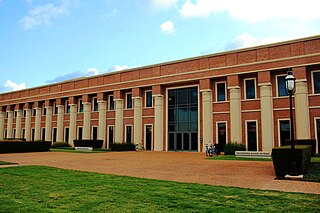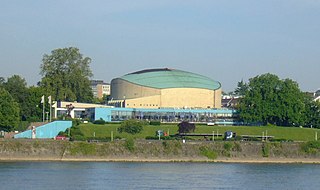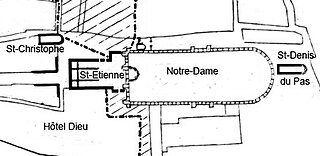
Metz is a city in northeast France located at the confluence of the Moselle and the Seille rivers. Metz is the prefecture of the Moselle department and the seat of the parliament of the Grand Est region. Located near the tripoint along the junction of France, Germany and Luxembourg, the city forms a central place of the European Greater Region and the SaarLorLux euroregion.

Ricardo Bofill Leví was a Spanish architect from Barcelona, Spain. He founded Ricardo Bofill Taller de Arquitectura in 1963 and developed it into a leading international architectural and urban design practice. According to architectural historian Andrew Ayers, his creations rank "among the most impressive buildings of the 20th century."

The Wiener Musikverein, commonly shortened to Musikverein, is a concert hall in Vienna, Austria, which is located in the Innere Stadt district. The building opened in 1870 and is the home of the Vienna Philharmonic orchestra.

The Trocadéro, site of the Palais de Chaillot, is an area of Paris, France, in the 16th arrondissement, across the Seine from the Eiffel Tower. It is also the name of the 1878 palace which was demolished in 1937 to make way for the Palais de Chaillot. The hill of the Trocadéro is the hill of Chaillot, a former village.

Canillo is one of the parishes of Andorra. Canillo is also the name of the main town of the parish. The parish is considered the religious center of Andorra with the Sanctuary and Chapel of Our Lady of Meritxell, patron saint of Andorra, and contains one of the best-preserved romanesque churches in the Pyrenees, Sant Joan de Caselles. It has a population of 4,826, as of 2011. Despite having a tourist vocation, the parish of Canillo still retains many livestock and agricultural traits.

The Shepherd School of Music is a music school located on the campus of Rice University in Houston, Texas. From its inception in 1974 under dean Samuel Jones, the Shepherd School has emphasized orchestral, chamber music, and opera as the central elements of its performing curriculum.

The Diocese of Metz is a Latin Church ecclesiastical territory or diocese of the Catholic Church in France. In the Middle Ages it was a prince-bishopric of the Holy Roman Empire, a de facto independent state ruled by the prince-bishop who had the ex officio title of count. It was annexed to France by King Henry II in 1552; this was recognized by the Holy Roman Empire in the Peace of Westphalia of 1648. It formed part of the province of the Three Bishoprics. Since 1801 the Metz diocese has been a public-law corporation of cult. The diocese is presently exempt directly to the Holy See.

Solís Theatre is Uruguay's most important and renowned theater. It opened in 1856 and the building was designed by the Italian architect Carlo Zucchi. It is located in Montevideo's Old Town, right next to the Plaza Independencia. The theatre was named after the explorer Juan Díaz de Solís, who was the first European explorer to land in modern day Uruguay.

The Coliseum of Porto is a Portuguese theatre and concert venue in the municipality of Porto, in northern Portugal, with a capacity for a standing audience of 4000. A leading venue for music and cultural events in Porto, together with Batalha Cinema, the Coliseu is an example of Portuguese Streamline Moderne and Art Deco styles in the city of Porto.

The Beethovenhalle is a concert hall in Bonn. It is the third hall in the city to bear the name of the Bonn-born composer Ludwig van Beethoven. The initial building was constructed in 1845 to commemorate the unveilling of the Beethoven monument at Münsterplatz, and a second was erected in 1870 to mark the 100th birthday of Ludwig van Beethoven. The second formation was destroyed during the second world war. In 1950, plans were initiated to reconstruct the building.

The Centre Pompidou-Metz is a museum of modern and contemporary art located in Metz, capital of Lorraine, France. It is a branch of Pompidou arts centre of Paris, and features semi-permanent and temporary exhibitions from the large collection of the French National Museum of Modern Art, the largest European collection of 20th and 21st century arts. The museum is the largest temporary exhibition space outside Paris in France with 5,000 m2 (54,000 sq ft) divided between 3 galleries, a theatre, and an auditorium.

The basilica of Saint-Pierre-aux-Nonnains in Metz, France, is one of the oldest churches in Europe. The building began life in the 4th century when Metz was an important Gallo-Roman city.
Metz, the capital and the prefecture of the Moselle department in France, has a recorded history dating back over 2,000 years. During this time, it was successively a Celtic oppidum, an important Gallo-Roman city, the Merovingian capital of the Austrasia kingdom, the birthplace of the Carolingian dynasty, a cradle of Gregorian chant, and one of the oldest republics of the common era in Europe. As an important city in the heart of Europe and the crossroads of different cultures, Metz has variously experienced an integration into the Roman Empire, the period of christianization, the barbarian depredations, religious wars, the French Revolution, the Industrial Revolution, an annexation into the German Empire, and World War II.

Ricardo Bofill Taller de Arquitectura (RBTA) is an architecture firm that was founded in 1963 by Ricardo Bofill, initially as Taller de Arquitectura (lit. 'Architecture Workshop'). It is headquartered in Sant Just Desvern near Barcelona, in a former cement factory known as La Fábrica.
The following is a timeline of the history of the city of Metz, France.

The Abbey of Notre Dame aux Nonnains, also called the Royal Abbey of Our Lady of Troyes, was a convent founded before the 7th century in Troyes, France. The non-cloistered canonesses became wealthy and powerful in the Middle Ages. In 1266–68 they defied the pope and used force to delay construction of the collegiate Church of St Urbain. They were excommunicated as a result. Later the abbey adopted a strictly cloistered rule and the nuns became impoverished. Work started on building a new convent in 1778 but was only partially completed before the French Revolution (1789–99). The abbey was closed in 1792 and the church was demolished. The convent became the seat of the prefecture of Aube.

The Metz Citadel was a fort built at Metz, northeast France in the second half of the 16th century.

La Fábrica is a former cement factory that was converted to offices and habitation space in the 1970s by Ricardo Bofill Taller de Arquitectura (RBTA). Located in Sant Just Desvern near Barcelona, it has been described as "the heart and brain of Bofill's professional and personal life." It has been widely published and, beyond its usage as the firm's head office, is a reference point in the work of RBTA.

The Basilica and Cathedral of Saint-Étienne in Paris, on the Île de la Cité, was an early Christian church that preceded Notre-Dame de Paris. It was built in the 4th or 5th century, directly in front of the location of the modern cathedral, and just 250 meters from the royal palace. It became one of the wealthiest and most prestigious churches in France. Nothing remains above the ground of the original cathedral. It was demolished beginning in about 1163, when construction began on Notre-Dame de Paris. Vestiges of the foundations remain beneath the pavement of the square in front of Notre-Dame and beneath the west front of the cathedral. The church was built and rebuilt over the years in the Merovingian, Carolingian and Romanesque architectural styles.


















